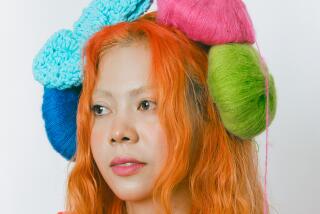First Lady Stimulates New Interest in Hand-Stitched Home Accessories
- Share via
With Barbara Bush in the White House, interest in hand-stitched home accessories is on the upswing, according to Kay Cook, executive director of the National Needlework Assn.
The First Lady, a devoted needle crafter, took nine years to complete the 10-by-14-foot needlepoint rug that is now in the family sitting room at the White House. While under construction, sections of the rug, in basket weave on No. 10 canvas, accompanied the Bushes to 17 countries and 36 states. The design includes personal data, such as grandchildrens’ initials and important family dates.
Barbara Bush, a skilled needleworker, said she undertook the lengthy project because “I wanted something that I wouldn’t outgrow. Something I would have forever.”
Model Cheryl Tiegs and TV actress Betty White are among other well-knowns who enjoy needle craft.
Between photo sessions, Tiegs is needlepointing a mirror frame. She said the personal aspect of the hobby is one of its most appealing attributes. Indeed, she stitches her initials and the completion date into each piece for an “extra personal touch.”
White, one of television’s “Golden Girls,” works on needlepoint on the set and in spare moments at home. She is most proud of two rugs she has completed, one with songbirds and another with seashells.
Needlepoint will soon be in the governor’s mansion in Cheyenne, Wyo. Jane Sullivan, wife of the governor, is having 24 chair seats in the formal dining room covered with needlepoint designs of Wyoming wildflowers.
In thousands of less famous homes, too, needlepoint is enjoying new popularity.
Cook estimated that in the past five years needle-craft shops have increased to 60% from 40% the amount of space devoted to needlepoint, cross-stitch and crewelwork supplies. These are the materials used to create pillows, wall decorations, fireplace screens, footstool covers, chair seats and rugs.
Another indication of increased interest: ready-made accessories are being snapped up by consumers who want the look without the work.
Designer Michael Jackson stocked his recently opened shop in Cross River, N.Y., with needlepoint cushions made in China. The cushions, with designs geared to American interiors, sell for about $200 apiece, and within a week he had sold all but one.
“Up till now,” he said, “if you wanted to have a needlepoint accessory in your room, you either had to do it yourself or inherit it.”
Designer Mario Buatta said he has been using needlepoint in interiors for 25 years to create an air of unstudied elegance. (His first placement was a King Charles spaniel pillow). Now he’s designing kits and ready-made cushions in a new needlepoint collection for Thimbelina, a manufacturer in Amagansett, N.Y. Designs include dogs, rabbits, flowers and fruit and can be worked into pillows, fire screens, scatter rugs, chair seat covers and framed wall pieces.
Prices range from $115 to $135 for the kits and from about $280 to $425 for the pillows. According to figures in Sew Business Magazine quoted by Cook, the average retail price for a hand-painted 14-inch needlepoint canvas is $41.73.
As decorative accessories, needlepoint designs have many pluses.
“They last for years,” Buatta said, “and give any room in which they’re used a warmth and individuality you just don’t get from plain old pillows. That pattern-on-pattern look of a needlepoint pillow on top of a chintz chair takes away the edge of looking too new and softens the room.”
Jackson suggested placing more than one needlepoint cushion on a chair or sofa. Mix sizes and shapes but group them according to subject matter or color. He said pillows with fringe or tiny cord bows are especially appealing.
Jackson said needlepoint cushions can be embellished with cord, ribbon, fringe or tassels.






